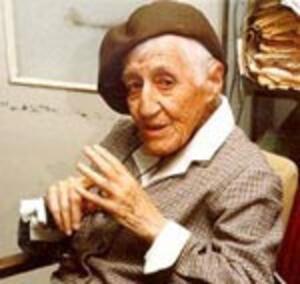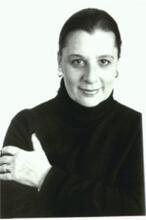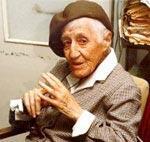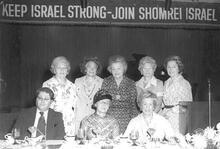Nehama Leibowitz
Nechama Leibowitz, born in Latvia in 1905, was a passionate educator, Zionist, and scholar. After immigrating to Israel in 1930, Leibowitz vigorously taught students in and outside of the classroom, eventually winning the prestigious Israel Prize in the Field of Education in 1956. Through her teaching, Leibowitz brought numerous people, including non-Jews, to a new conception of Torah study. She refused to acknowledge that she was a revolutionary in any way, but ultimately her unique achievements changed Orthodox society’s perception of a woman’s capabilities and undoubtedly opened doors for the female Torah scholars who followed. Leibowitz died in 1997, and to this day is still “teaching” Torah to new generations, through her books, methods, and students, many of whom are prominent teachers and rabbis.
Personal Life and Early Career
Nehama Leibowitz was born in 1905 in Riga, Latvia, to Mordechai and Freyda Leibowitz. She grew up in a home filled with Jewish and general culture, competing in her father’s Bible quizzes against her brother, Yeshayahu, who later became a famous and controversial Israeli philosopher. In 1919 the family moved to Berlin, where Leibowitz taught, wrote articles and studied for her doctorate. She married her uncle, Lipman Leibowitz, who was many years her senior, and on the day she finished her doctorate they fulfilled their dream and moved to Israel (c. 1930).
Leibowitz’s combination of personality traits—a keen mind, warmth, humor, dramatic flair and insight—as well as the breadth of knowledge she had acquired at home and at university, made her an excellent teacher and she even began training other teachers while still in her twenties, eventually publishing several works of pedagogical insights into Bible teaching. She traveled around the country on buses, in taxis, and on airplanes teaching Bible and commentaries to teachers, new immigrants, soldiers, kibbutzniks, and thousands of ordinary people. She received a professorship at Tel-Aviv University in 1968 and was awarded several prizes in the course of her life, including the prestigious Israel Prize in the Field of Education (1956).
Teaching and Study Methods
In 1942, some of Leibowitz’s students decided that they wanted to continue studying her material even after the school year had ended. Acceding to their request, Leibowitz began mailing them her worksheets, which contained commentaries unavailable at the time and, furthermore, challenged them with difficult questions, with every answer checked personally by Leibowitz. Word spread to friends and neighbors, who also wished to fill out these sheets. Eventually the correspondents ran into the thousands: young and old, religious and secular, kibbutzniks and city-dwellers. Thus Leibowitz functioned as a one-woman Open University correspondence course for over thirty years without ever receiving remuneration.
Through her teaching, her worksheets, and the famous Iyyunim/Studies series of books on the weekly portion, appearing in six languages on bookshelves from Jerusalem to Guatemala, Leibowitz brought numerous people, including non-Jews, to a new conception of Torah she-bi-khetav: Lit. "the written Torah." The Bible; the Pentateuch; Tanakh (the Pentateuch, Prophets and Hagiographia)Torah study. She salvaged the classic commentaries on Bible from the musty attic to which they had been relegated by both the Yeshiva world, which focused almost exclusively on Lit. "teaching," "study," or "learning." A compilation of the commentary and discussions of the amora'im on the Mishnah. When not specified, "Talmud" refers to the Babylonian Talmud.Talmud, and the secular world, whose interest lay in Biblical Criticism, archeology, and history. She—and her students after her—revolutionized the world of Torah study; and today, Leibowitz’s question, “What’s Rashi’s difficulty?” is commonplace, as is her method encouraging comparison and evaluation of commentaries.
This latter method introduced a certain level of pluralism into the study of Torah; many voices of interpretation were allowed—including even certain non-Orthodox scholars, who Leibowitz insisted were very valuable, despite the criticism she received—and they were subjected to a rigorous analysis and evaluated for their faithfulness to the text.
Leibowitz’s Outlook
However, Leibowitz, always the educator, did not make do with comparing and contrasting; she almost inevitably liked to emphasize a moral message deriving from the study. Thus she writes: “If we accept that the midwives were Egyptian, a…very vital message becomes apparent. The Torah indicates how the individual can resist evil. He need not shirk his moral responsibility under cover of ‘superior orders.’ The text contrasts the brutal decrees of enslavement and massacre initiated by Pharaoh and supported by government and people with the godfearing ‘civil disobedience’ of the midwives. Neither moral courage not sheer wickedness are ethnically or nationally determined qualities. Moab and Ammon produced a Ruth and Naamah respectively, Egypt two righteous midwives.”
This message, upholding the less accepted reading of this passage—i.e., that the midwives were Egyptian—derived from Leibowitz’s own outlook and emphases and was not one that others would necessarily have promoted. It is also clearly inspired by her twentieth-century context, echoing the evasion of responsibility of those who cited “superior orders” during the Holocaust, something she explicitly addresses elsewhere. She indeed believed that all of these messages can and must be relevant to modern life, as she says, paraphrasing Moses ben Maimon (Rambam), b. Spain, 1138Maimonides:
“The lack of thought content, the dearth of a religious message must be traced to the incapacity of the student in failing to detect the eternal inner significance underlying the apparent, drily technical, historical details. ‘If it seems a vain thing—it is your fault’”
(Studies in Bamidbar, 393).
Loathing as she did the approach of Biblical Criticism, Leibowitz turned to the newly developing literary approach as a method within academia that would be consistent with her beliefs. She rejected the archeological, geographical and historical dimensions of the text as irrelevant to its true message; according to her, a shepherd was far less likely to contribute insight to Psalm 23 (“The Lord is my Shepherd”) than would be a person on his or her deathbed.
Techniques of Literary Analysis
In the footsteps of Martin Buber, Franz Rosenzweig, Ludwig Aryeh Strauss, Umberto Cassuto, Benno Jacob, and her friend and colleague Meir Weiss, whose work was based on that of the New Critics, Leibowitz adopted and expanded upon various new techniques for literary analysis. She felt that these were very close to the Midrashic method and that of the Sages and commentaries, with their close reading of the text. When her work is examined carefully, and despite her protestations to the contrary, she may even be discovered to have done some original literary analysis of her own. On this level, she may be said to have been not “only a teacher,” as she claimed, but also truly a scholar of Bible, indeed, one of the pioneers in the literary-aesthetic approach to Biblical interpretation. Some of her work also bears an affinity to postmodernist theories.
Personal Beliefs
Leibowitz’s humility was legend. She insisted that everyone call her “Nehama” and refused to let newspapers interview her, or to allow people to come simply in order to meet her, declaring, “I am not a museum!” Her simplicity of lifestyle was striking too; people entering her apartment were often struck speechless at how little physical comfort she allowed herself. Famously, she gave a beggar a brand new suit she had just bought herself. When challenged as to why, she retorted, “Should I give him old and worn clothes?” Leibowitz loved simple people and her poignant stories about taxi drivers and their wisdom are often quoted by her students.
A passionate Zionist, Leibowitz refused to leave Israel even when offered large sums of money to lecture abroad. She believed that Torah must be taught in Hebrew and that Hebrew should also be the language spoken by all Jews. She was a deeply religious person, but of the sort that emphasized The legal corpus of Jewish laws and observances as prescribed in the Torah and interpreted by rabbinic authorities, beginning with those of the Mishnah and Talmud.halakhah and Torah study, moral responsibility, ethics and humanistic focus, rather than ecstatic and mystical dimensions, which she feared might prove shallow or transient. Thus she had little to do with A member of the hasidic movement, founded in the first half of the 18th century by Israel ben Eliezer Ba'al Shem Tov.hasidim or The esoteric and mystical teachings of JudaismKabbalah. She disapproved of superstition, contesting the practice of investing holiness in Jewish saints and praying to them; and, at the same time, believed that the heroes of the Bible, whom she respected and loved tremendously, were also not to be overly exalted. The Torah itself marks their flaws, and so can—and should—we.
Leibowitz also opposed the ideas of feminism and the feminist movement; several feminists who were close to her, such as Blu Greenberg and Chana Safrai, attempted to persuade her to change her mind, but without success. While she upheld equal pay and rights for women, Leibowitz did not consciously desire to change the balance of designated gender roles within traditional Jewish society.
The fact that she herself had been brought up in complete intellectual equality with her brother was probably a primary source of her self-confidence and powerful teaching, to the point of reducing some of the many distinguished rabbis in her class to anxious schoolboys. But she never referred to her good fortune in this respect or to the effect its absence might have in other homes.
While she believed women should study Torah, and refused to countenance attempts to remove women from her Torah classes; and while she even referred to the Talmud from time to time—certainly an unusual phenomenon for a woman in the earlier years of her career—Leibowitz rejected the drive for women to take on more commandments, such as communal roles or laying of Phylacteriestefillin, as representing not the result of authentic religious emotion but rather ideas promulgated by the secular feminist movement. “Torah study constitutes gratification for women, and to take away this intellectual enjoyment and activity is an injustice; but when it comes to keeping A biblical or rabbinic commandment; also, a good deed.mitzvot, you just have to do what God says,” she explained.
Later Life and Legacy
Leibowitz refused to acknowledge that she was a revolutionary in any way; but ultimately her unique achievements changed Orthodox society’s perception of a woman’s capabilities and undoubtedly opened doors for the female Torah scholars who followed; this itself is proof of the power of gradual, evolutionary change. It is this duality of self-definition and deeds that leads to the fact that Leibowitz may be claimed by all camps as their own; she is held up as a beacon of modesty and learning by conservative elements, whilst feminists point to her impact and consider her an important milestone in Jewish women’s empowerment.
All her achievements notwithstanding, the childless Leibowitz confided that she would have given it all up to have children. But at her funeral in 1997, her nephew announced, “All those who feel, as I do, like a son to Nehama, may join in the Lit. (Aramaic) "holy." Doxology, mostly in Aramaic, recited at the close of sections of the prayer service. The mourner's Kaddish is recited at prescribed times by one who has lost an immediate family member. The prayer traditionally requires the presence of ten adult males.Kaddish prayer with me”; and suddenly, from all quarters, thousands of voices rose in unison to say: “Yitgadal ve-yitkadash shmei Rabba.”
In accordance with her request, on her gravestone was written only “Nehama Leibowitz: Teacher.” And to this day, she is still “teaching” new generations Torah, through her books, her methods and her students, many of whom are prominent teachers and rabbis in the Jewish world.
Her impact has been primarily within Modern Orthodoxy, but many non-Orthodox and secular people have also been exposed to her work, and even some ultra-Orthodox elements recognize her greatness. One such yeshiva student, embarrassed to be heard quoting a woman, changed her name slightly when repeating her Torah, and thus, unbeknownst to her, Nehama was summarily transformed into Reb Nahman.
Major Works
The Iyyunim series (In English: Studies in Bereshit. Jerusalem: Histadrut haTzionit haOlamit, 1972.
New Studies in Shemot: Yitro (Exodus 1–20). Jerusalem: World Zionist Organization, 1980.
Mishpatim-Pekudei (Exodus 21–39). Jerusalem: World Zionist Organization, 1976.
New Studies in Vayikra. Jerusalem: World Zionist Organization, 1980.
Studies in Bamidbar. Jerusalem: World Zionist Organization, 1980.
Studies in Devarim. Jerusalem: World Zionist Organization, 1980.
Lessons in Chapters of Comfort and Redemption (Hebrew; with Meir Weiss). Jerusalem, 1958.
Pamphlets for the Study of the Book of Jeremiah (Hebrew). Jerusalem: 1974.
Teaching the Commentators on the Torah: Exodus (Hebrew). Jerusalem: World Zionist Organization, 1995.
The Study of Commentators on the Torah And Methods of Teaching Them: Genesis (Hebrew). Jerusalem: World Zionist Organization, 1975.
Rashi’s Commentary on the Torah (Hebrew; with Moshe Ahrend). Ra’anana: The Open University of Israel, 1990.
To Teach and to Study Tanakh (collected articles, in Hebrew; published in English as “Torah Insights.”) Jerusalem: World Zionist Organization, 1995.
Books
Abramowitz, Leah. Tales
of Nehama.
Jerusalem: 2003.
A popular biography. The first half is made up largely of anecdotal material
based on interviews. The second half comprises 170 pages of reprinted articles.
Ahrend, Moshe, Ruth Ben-Meir and Gavriel H. Cohn. “Pirkei
Nehama”: Memorial
Volume for Nehama Leibowitz (Hebrew).
Jerusalem: 2001.
This hefty volume (over 700 pages) contains many academic articles by Leibowitz’s
students, bearing more or less connection to her actual work; plus reprints
or first-time prints of articles by Leibowitz. This is the most authoritative
and comprehensive volume about Leibowitz to date.
Frankel, Marla. “A Clarification of Nechama Leibowitz’s Approach to the
Study and Teaching of Bible” (Hebrew). Ph.D. diss.,
Hebrew University of Jerusalem, 1997.
Frankel has done extensive work on Leibowitz’s pedagogical methods. She has
discovered different types of “teachers” within Leibowitz’s work, for example
the pedagogue and the facilitator.
Ochs, Vanessa L., Words on Fire: One Woman’s Journey into the Sacred. San
Diego: 1990.
Ochs spent time in Jerusalem in the 1980s learning Torah, including studying
with Leibowitz, and wrote a book about her experiences. Although Leibowitz
would have been very unhappy at this kind of description of herself, Ochs’s
first-hand description of Leibowitz conveys a more colorful idea of who she
was and the context in which she functioned.
Peerless, Shmuel. To
Study and to Teach: The Methodology of Nechama Leibowitz. Jerusalem:
2003.
A systematic presentation of some of Leibowitz’s pedagogical and methodological
techniques, including sample lessons.
Reiner, Yitshak, and Shmuel Peerless (eds.). Studies
on the Haggadah from the Teachings of Nehama
Leibowitz. Jerusalem: 2002.
A collection of Leibowitz’s teachings arranged according to the Passover Haggadah.
Unterman, Yael. “Background and Examples of Nechama Leibowitz’s Literary
Approach to Bible.” M.A. thesis, Touro College Israel Branch. Jerusalem: 2002.
The author’s conclusions have since been somewhat revised and can be found
in the article “Literary Aspects of Nehama
Leibowitz’s Reading of Bible” (see below).
Articles
Ahrend, Moshe. “The text demands study” (Hebrew). Bi-Sdei
Hemed
11 (1968): 30–37.
Ahrend was Leibowitz’s colleague for many years.
Amit, Yairah. “Hebrew Bible—some thoughts on the work of Nehama Leibowitz.”
Immanuel
20 (Spring 1986): 7–13.
Amit, who was Leibowitz’s eventual successor at Tel Aviv University, provides
the perspective of a secular Israeli academic with first-hand knowledge of
Leibowitz’s work.
Angel, Hayyim J. “The Paradox of Parshanut: Are our Eyes on the Text or on the Commentators? Review of Pirkei Nehama.” Unpublished essay (to be published in Tradition magazine).
Breuer, Mordechai, “Nehama
Leibowitz’s Approach to Biblical Science” (Hebrew). Limmudim
1 (2001):
11–20.
Leibowitz was an extremely severe critic of Breuer’s approach to the Bible;
he was an Orthodox scholar who admitted some of the findings of Biblical Criticism,
although not its fundamental premise.
Bonchek, Avigdor. “Professor Nechama, Teacher of Israel.” Jewish Action (Fall 1993): 16–27; Cohn, Gabriel H. “Nehama Leibowitz—Teacher of Torah.” Be-Khol Derakhekha Da’ehu, Journal of Torah and Scholarship, Bar-Ilan University 6 (Winter 1998); Cohn, Gabriel H. “For Me the Torah of Your Mouth is Good” (Hebrew). Amudim (1997): 277–280.
Dietcher, Howard, “Between Angels and Mere Mortals: Nechama Leibowitz’s Approach
to the Study of Biblical Characters.” Journal
of Jewish Education 66/1 Spring/Summer 2000).
In this article we are given insight into Leibowitz’s belief that Biblical
heroes are not immune to criticism.
Frankel, Marla. “The Teacher in the Writings of Nechama Leibowitz.” In Abiding
Challenges: Research Perspectives on Jewish Education. London and Tel
Aviv: 1999, 359–374; Greenstein, E., ed. Nehama
Leibowitz’s Multifaceted Interpretation and Postmodern Interpretations (Hebrew).
Limmudim
1 (2001): 21–33.
Greenstein claims that some of Leibowitz’s methods approach postmodern interpretation,
despite the fact that she was so overtly modernist in much of her literary
work.
HaCohen, Aviad. “Hear
the Truth from the One Who Says It—This Is an Important Principle in Nehama
Leibowitz’s Philosophy”
(Hebrew). Alon
Bogrim 13 (1999): 71–92.
This article outlines Leibowitz’s use of non-Orthodox scholars and gives a
theoretical rationale for it, although the truth is that Leibowitz simply
continued the approach that she was taught at home.
Harvey, Warren Zev. “Professor Nehama Leibowitz, Israel’s Teacher of Teachers.” Canadian Zionist 50/4 (April/May 1981): 10–11, 18.
Mondshein, Aaron. “The Binding of Isaac—between Faith and Doubt” (Hebrew). Beit Mikra 44/2 (1999): 107–118.
Rochwarger, Joy. “Words on Fire: Then and Now—In Memory of Nechama Leibowitz.” In Torah of the Mothers. Jerusalem: 2000.
Rosenak, Michael. Roads to the Palace: Jewish Texts and Teaching. Providence: 1995.
Rosensohn, Yisrael. “Commentary, Interpretation and History: Notes on Nehama Leibowitz’s Exegetical Approach” (Hebrew). Al Derekh Ha-Avot (2001): 433–453.
Salmon, Rachel. “Nehama Leibowitz, Scholar and Teacher.” Kol Emuna (Spring 1987): 16, 19.
Segal, Sheila. Women of Valor: Stories of Great Jewish Women Who Helped
Shape the Twentieth Century. Springfield, NJ: 1996.
Sokolow, Moshe. Index to the Worksheets (Hebrew). Jerusalem: 1993.
Strikovsky, Arie, ed. Nehama Leibowitz (Hebrew). Pamphlet for Jewish Culture 228. Torah Education Department of the Ministry of Education. Jerusalem: 1997.
Unterman, Yael. “Literary aspects of Nehama Leibowitz’s Reading of the Bible.” To be published in conjunction with McGill University.
Urbach, Ephraim Elimelech. “Reading the Worksheets on the Weekly Portion”
(Hebrew). Mayanot
4 (1954): 55–58.
In this oft-quoted article, Urbach calls upon Leibowitz to write a much-needed
new commentary on the Torah.
Weinberg, David. “Remembering Nehama.” The Jerusalem Post, April 5, 1998; Yedgar, Erella. “Between an Exegetical-Didactic and a Conceptual-Educational Approach in Nehama Leibowitz’s Writings” (Hebrew). Limmudim 1 (2001): 45–80.






